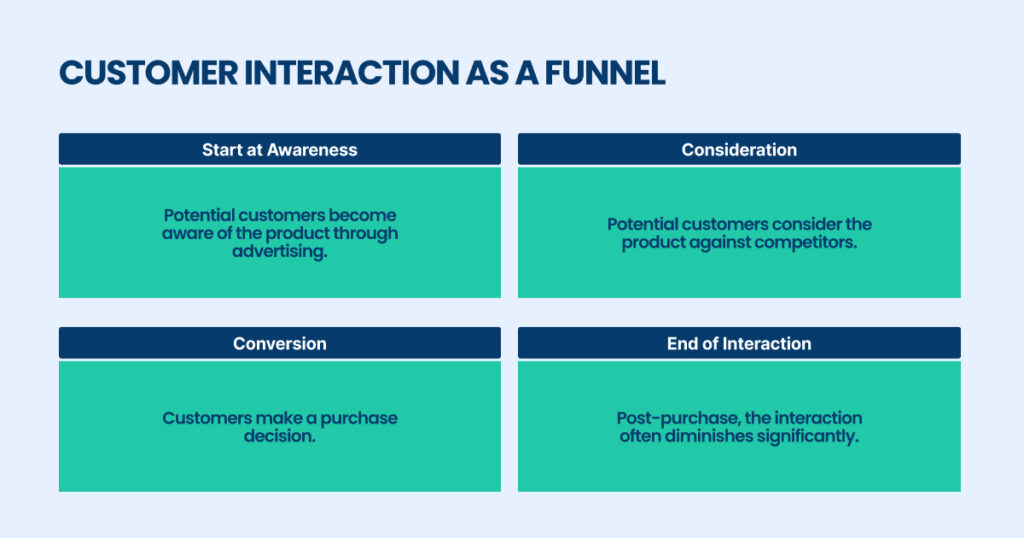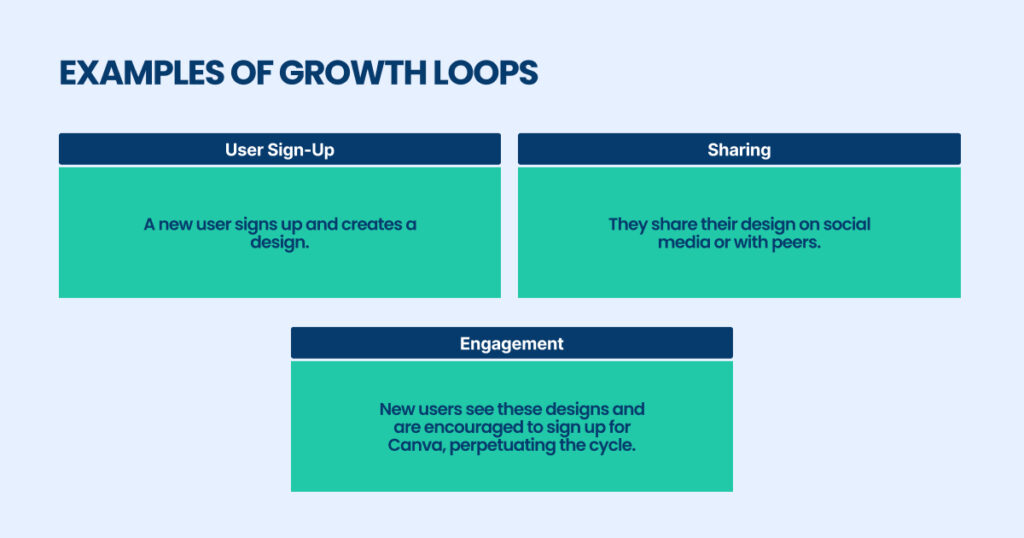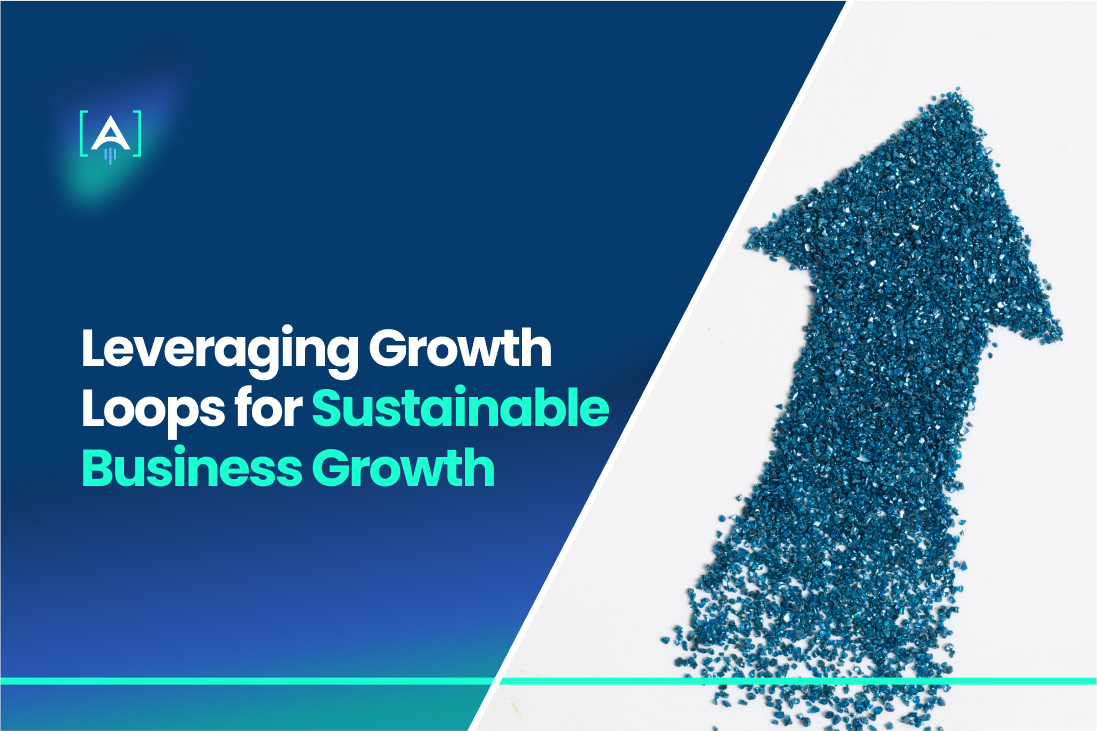Sustainable business growth isn’t just about profit. It’s about achieving a balance.
Marketing is next to that. Of course, it tries to understand and meet customer needs to retain them and attract new ones.
Any growth marketing agency targets finding new ways to operate more efficiently during the process.

The blog post will introduce the leveraging growth loops that can benefit the success of sustainable business.
Defining Growth Loops
Growth loops represent a transformative concept in the marketing landscape, especially in growth marketing.
Unlike traditional linear marketing models, where each campaign is designed to push the consumer from awareness to decision sequentially and often independently, growth loops create a self-sustaining cycle where the outcome of one cycle initiates the next.
This innovative approach emphasizes continuous engagement and re-engagement of customers, creating a loop that drives sustainable growth over time.
Comparison with Traditional Growth Models
Traditional growth models typically rely on paid vs. organic marketing efforts, where each investment in advertising is expected to yield a proportional return on customer growth and acquisition.
This model often views customer interaction as a funnel, leading to a finite transaction endpoint:

In contrast, growth loops incorporate the customer deeper into the growth mechanism, often turning them into advocates who propel the loop forward:
- Continuous Cycle: After conversion, the customer’s actions contribute to attracting new users.
- Self-perpetuating: Each customer’s engagement generates further engagement, creating a loop.
- Focus on Retention: Continuous engagement enhances customer retention, which is often more cost-effective than acquisition.
Importance of Growth Loops in Modern Business
Growth loops in today’s digital marketplace are increasingly vital because they can leverage organic and cost-effective growth methods over more expensive and less sustainable tactics.
Businesses implementing growth loops effectively can experience exponential growth by tapping into powerful dynamics like network effects and user-generated content.
Benefits of Using Growth Loops
Implementing growth loops offers numerous advantages that align well with the objectives of modern businesses striving for sustainability and robust customer relationships:
- Cost Efficiency: Reduces reliance on paid marketing channels, optimizing the marketing budget.
- Enhanced Customer Retention: Engages customers continuously, enhancing their lifetime value.
- Viral Growth Potential: Employs mechanisms like referrals and social sharing that can significantly amplify organic reach.
- Scalability: As the business grows, the loops can expand accordingly, often with minimal additional input.
- Data-Driven Insights: This approach encourages the use of AI and analytics to refine the loops based on real-time feedback and AI ROI.
Examples of Growth Loops
One of the most illustrative examples of successful growth loops can be seen in platforms like Canva:

Implementing Growth Loops
To effectively implement growth loops, a business needs a clear experimentation roadmap and a commitment to continuously refining its strategies based on customer feedback and data.
Growth marketing agencies often play a crucial role in designing and executing these loops. They use advanced tools and frameworks to measure the impact of different loop strategies and adjust them to maximize growth.
The implementation process typically involves:
- Identifying Key Touchpoints: Determine where customers can be encouraged to contribute to growth (e.g., referral prompts and social share buttons).
- Integration with AI: Utilize AI to analyze behavior patterns and automate parts of the loop for better efficiency.
- Continuous Optimization: Use insights from data to refine the loop, enhancing both the user experience and the loop’s effectiveness.
Growth loops represent a significant evolution from traditional growth models, offering a dynamic and sustainable way to drive business success.
As modern businesses increasingly look to build enduring customer relationships and maximize their marketing spend, growth loops stand out as a compelling strategy driven by innovation and a deep understanding of market dynamics.
Types of Growth Loops
Growth loops, a cornerstone of modern growth marketing strategies, have proven highly effective in driving sustainable business growth.
Source: The Product Manager
By re-engaging users in a cycle that promotes continuous growth, these innovative marketing strategies eliminate the traditional end-point of customer acquisition and open up new avenues for ongoing engagement and expansion.
Below, we explore the different types of growth loops, each distinguished by its unique mechanisms and outcomes.
Viral Loops
Viral loops are one of the most potent growth loops, designed to exponentially increase brand awareness and user acquisition through word-of-mouth and social sharing mechanisms.
Source: The Product Manager
The essence of a viral loop is that it encourages existing users to share the product with their network, who in turn become new users and continue the cycle.
Examples of Successful Viral Loops
A prime example of a viral loop is the referral program implemented by Dropbox.
Users were incentivized to invite friends to use the service with additional free storage space for the referrer and the referee. This boosted their user base and increased engagement as users became more invested in the platform and accumulated more storage.
Another example is the way platforms like Canva facilitate user growth. When a user sign up for Canva and create a design, they are likely to share their creation on social media.
This showcases Canvas’s capabilities to a broader audience, prompting new users to sign up and explore the tool, thus perpetuating the growth loop.
Content Loops
Content loops capitalize on the creation and distribution of beneficial content to attract and engage users. These users then help spread the content further, drawing in more users. This type of growth loop is particularly effective for establishing thought leadership and building brand authority.
Strategies for Building Content Loops
To build an effective content loop, organizations must focus on producing high-quality, relevant content that addresses the demands and interests of their target audience. SEO plays a crucial role here, optimizing content to guarantee it ranks well in search engines and captures organic traffic.
Moreover, integrating AI tools can help understand trending topics and user preferences, thus enhancing the content’s relevance and reach.
Content should be easy to share, with clear call-to-action buttons and incentives for sharing, such as access to more detailed content or contest entries. Over time, as the audience grows, user-generated content can also become a significant part of the content loop, with users contributing their own insights and experiences, attracting more new users.
Product-Led Growth Loops
Product-led growth loops focus on the product as the key driver of customer acquisition, expansion, and retention. This approach relies on the product’s inherent value and usability to motivate users to engage deeply and recommend the product to others.
Key Components and Implementation
Key components of a successful product-led growth loop include a highly functional product that addresses a significant need, an intuitive user experience, and features that encourage sharing and collaboration.
For example, many SaaS companies use freemium models, in which users can access basic features for free but can see the added benefits of upgrading or inviting more team members.
The implementation of this growth loop often begins during the marketing agency onboarding process, where the product’s value and usability are emphasized.
AI marketing tools can track user behaviors and preferences, allowing for personalized experiences that enhance satisfaction and encourage advocacy.
Growth Loops: The Engine of Modern Marketing Strategies
The growth loop model presents a transformative approach in modern marketing, moving beyond traditional linear strategies to a more dynamic, self-perpetuating growth system.
Source: The Product Manager
At its core, a growth loop involves creating processes where each user action contributes to further actions, bringing in more users and creating a continuous cycle that can drive sustainable growth.
- Key Characteristics: A successful growth loop leverages user actions as a significant driver for organic growth.
For example, a user might sign up for a service like Zapier, automate a workflow, experience immediate benefits, and share these results with peers who also sign up. - Mechanics of the Model: Effective growth loops incorporate feedback mechanisms that continually adjust and optimize the user experience based on user data and behaviors.
This could involve using AI to fine-tune the process or gathering user feedback to enhance service offerings. - Example in Action: In the context of social media marketing, a growth loop might look like this: A user discovers a tool via a social media ad, uses the tool to automate their social media posts, and as their efficiency increases, they share their positive experience online, attracting more users to the tool.
Exploring the Limitations of Growth Loops
While growth loops offer significant advantages, they are not without their challenges and limitations.
Understanding these can help businesses better prepare and strategize to mitigate potential downsides.
- Dependency on High User Engagement: Growth loops heavily rely on high levels of user engagement. The loop can quickly stagnate if the initial user experience doesn’t strongly motivate sharing or further interaction.
- Scaling Challenges: As the user base grows, the original loop may struggle to maintain its effectiveness at scale. This might require additional resources or changes to the loop to manage a larger user base efficiently.
- Complexity in Implementation: Designing a growth loop that perfectly aligns with user behavior and business goals can be complex and often requires a growth model with continuous tweaking and testing to get it right.
Practical Examples of Growth Loop Implementation
Practical examples provide insights into how real companies successfully implement growth loops to drive engagement and growth.
- Intercom’s Customer Engagement Loop: Users who sign up for Intercom configure the chat system to interact with their customers.
This immediate enhancement in customer service often leads to a noticeable improvement in user satisfaction and retention, encouraging the new user to recommend Intercom to others. - Zapier’s Workflow Automation Loop: Upon signing up for Zapier, users quickly see the benefits of workflow automation. Users who integrate more apps and streamline processes share these successes within their professional networks, driving more sign-ups.
- Content-Driven Loops: Companies often use valuable content as a part of their growth loops. When users access useful content, they’re likely to share it, bringing more traffic to the site and encouraging new users to engage with it, thus continuing the cycle.
These examples underscore the importance of designing a growth loop that attracts users and actively involves them in an ongoing cycle of engagement, sharing, and retention, not considering growth loops as the limitations.
By carefully planning and implementing these loops, companies can harness the full power of organic growth, driving long-term success and sustainability.
Challenges and Solutions in Implementing Growth Loops
Implementing growth loops within a business strategy can dramatically enhance efficiency and foster organic growth.
Source: The Product Manager
However, certain pitfalls can undermine their effectiveness, requiring awareness and strategic planning to avoid.
- Limited Scope and Innovation: One of the most common pitfalls in designing growth loops is focusing too narrowly on a single loop or strategy.
This overreliance can diminish returns if the loop doesn’t evolve with changing user behaviors or market conditions. - Ignoring User Feedback: Growth loops depend heavily on user engagement and feedback. Ignoring this feedback can lead to a loop that does not resonate with users, making it less effective and reducing its impact on growth.
- Complex Integration: Introducing a growth loop into existing processes can sometimes be complex and disruptive. If not integrated smoothly, it can lead to user confusion and disengagement.
Overreliance on Single-Loop Strategies
Focusing heavily on one growth loop, even if initially successful, can be risky. Marketers understand the power of growth loops. Markets evolve, and so do user expectations.
A strategy that depends on a single loop might not be flexible enough to adapt to new challenges or opportunities, potentially stalling growth and allowing competitors to gain an edge.
- Example: A company using a referral loop might find great success initially but may struggle as the market becomes saturated. The loop alone isn’t enough to sustain growth without innovation or expansion into new areas.
Strategies to Overcome These Challenges
To maximize the effectiveness of growth loops and mitigate potential pitfalls, companies can adopt several strategic approaches:
- Feedback Mechanisms: Establish robust channels for capturing and analyzing user feedback. This input should inform adjustments and iterations in the growth loop, ensuring the strategy remains aligned with user needs and preferences.
- Agility in Processes: Maintain flexibility in marketing strategies to adapt quickly to new information or market trends. This agility can help pivot or modify growth loops in response to effectiveness and engagement metrics.
Diversification and Iterative Testing
Diversification and iterative testing are crucial for the sustainable success of growth loops.
By not putting all eggs in one basket and continuously testing different aspects of the loop, companies can enhance their growth strategies and mitigate risks associated with market changes.
- Diversification: Implementing multiple growth loops can protect a business from overreliance on one strategy. For example, combining user referral loops with content-driven loops can capture a broader segment of potential growth opportunities.
- Iterative Testing: Regularly testing and modifying the elements of a growth loop based on real-world data and user interactions can lead to continuous improvement and innovation.
This approach allows businesses to refine their strategies to meet the needs of the target audience better and adapt to changing market conditions, if you consistently propose questions to ask growth agency.
Partner with [A] Growth Agency
Sustainable growth isn’t about quick wins. Businesses need to adapt and improve to stay ahead of the competition constantly.
At [A] Growth Agency, we specialize in developing tailored growth loops that engage and retain your current customers and continuously attract new ones.
Our expert growth team is proficient in designing various types of growth loops. Moreover, leveraging cutting-edge analytics and AI marketing tools, we ensure that every decision and adjustment in your growth loop strategy is informed by well-researched data.
Stay ahead of your competitors with our novel strategies!

